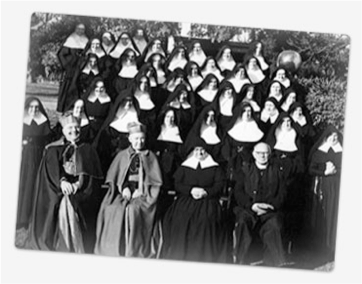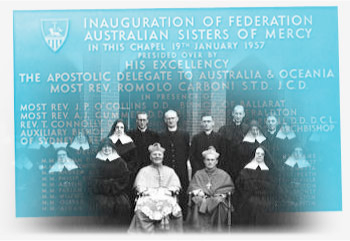The Union
Eventually eight of the congregations chose to do so and in July, 1954 the Congregation of the Australian Union of the Sisters of Our Lady of Mercy (the Union) was formed from the Congregations of Adelaide, Bathurst, Goulburn, Gunnedah, Melbourne, Perth, Singleton and Wilcannia-Forbes.


Delegates to the first General Chapter of the Union with the Apolstolic Delegate Archbishop Carboni, Cardinal N Gilroy and Father N Jordan MSC.
The Federation
The other nine congregations continued to examine the issue of unity until, on the advice of Archbishop Marella’s successor, Archbishop Romolo Carboni, they held a vote among their sisters to determine whether they would join the new Union, form a separate union, form a federation, or remain completely independent.
They chose the structure of a federation in which each member congregation would maintain its autonomy. Thus, in November 1955 the Congregations of Ballarat East, Brisbane, Cairns, Grafton, North Sydney, Parramatta, Rockhampton, Townsville and West Perth formed the Australian Federation of the Sisters of Mercy.


First meeting of the Federation Council, 1957 and the Federation plaque.
Mission to Papua New Guinea
In 1955 Archbishop Carboni, whose mandate as Apostolic Delegate extended throughout Oceania, requested the Union to establish a mission in Papua New Guinea. The response was quick and generous and in 1956 four sisters went to Goroka in the Eastern Highlands. He made the same request of the Federation and in 1957 seven sisters went to Kunjingini in the Diocese of Wewak and the next year five more went to Torembi.

 View the Arrival in PNG
View the Arrival in PNG